A Novel Method to Determine the Optimal Location for a Cellular Tower by Using LiDAR Data
Abstract
:1. Introduction
2. Research Question on the Placement of Cellular Tower(s)
3. Methodology
- (a)
- Establishment of an accurate model to predict the signal strength at a user location after transmission of a signal from a cellular tower location.
- Development of a model inputting accurate 3D terrain data, cellular tower and user location(s), and signal strength at tower location to determine the strength at desired user locations.
- Extraction of detailed routes for transmission of signals using 3D LiDAR data.
- Estimation of terrain parameters and dependent transmission losses for every route between each tower and user pair as a modeling input.
- Verification of the model for a wide variety of terrain geometry and a large number of points.
- Generation of 3D signal strength map for a cellular tower to its all-neighboring users’ locations.
- (b)
- Establishment of a technique to determine the optimum location for setting up a cellular tower using an accurate signal strength prediction model.
- Estimation of optimum location in X, Y, and Z for an area.
- Determination of optimality at the rough grid in X, Y, e.g., 100 m × 100 m, then refinement to a very fine grid, 2 m × 2 m.
- Determination of optimality in height (Z) about heights of user’s locations.
- (c)
- Establishment of a technique to determine the optimum number and locations of the cellular tower for an area to offer good/acceptable quality of signal strength to most users.
- Estimation of number and locations of the cellular tower using a signal strength prediction model and optimality prediction model.
- Establishment of global optimality maintaining a trade-off between over design and under design and good/adequate signal strength requirement for an area.
4. Results and Discussions
4.1. Determination of the Strength of the Signal
4.1.1. Location of Existing Towers and Cell phone Users
4.1.2. Terrain Parameter Determination
4.1.3. Relation between Signal Strength and Terrain Parameters
4.1.4. Validation
4.2. Optimal Location(s) for Setting up Cell Phone Tower(s)
4.2.1. Rural Area (RGIPT Campus)
- Taking one case out of different combinations and isolating the three equal areas as shown in Figure S14, the isolated area is shown in Figure S15a.
- Taking one isolated area out of three mentioned as (Area 1) and fitting the area in the rectangle “LMNO” is shown in Figure S15b.
- Similarly, for the three locations of the tower, the signal strength map is shown in Figure S18a.
- For the (P = 2) cell phone tower: Similarly, for the two locations of the tower, the signal strength map is shown in Figure S18b.
4.2.2. Urban Area (Shahganj Area of Agra City, India)
- Two-dimensional mapping of Agra city area: The Shahganj area of Agra city has five (JIO network towers), which are shown in Figure S20a, and the signal strength due to these towers is shown in Figure S20b. After applying the algorithm to an area of Agra city, the proposed locations for five towers have come in different sets of combinations. Out of these combinations, one has to be chosen that gives the best result. These positions are shown in Figure S21a, and the signal strength map is shown in Figure S21b. For the city location, LIDAR data are generated, which are shown in Figure S19b. For the generated LIDAR data shown in Figure S19b, DEM is created, which is shown in Figure S19c.
- Three-dimensional mapping of Agra city area: 3D map for the previous tower at Shahganj area is shown in Figure S23a, and a 3D map for the proposed tower location is shown in Figure S23b. While determining the signal strength due to the four proposed towers, the dB m lies between −53.73 and −88.58 (dB m) and is shown in Figure S20b.
- Effect of towers at Building: A building is taken out from the Shahganj area, and the effect of cell phone towers on that particular building is shown in Figures S21a and S24a. This is done for two cases of previously installed towers and proposed towers. It is clearly shown in Figure S24b that signal strength is improved in the case of proposed cell phone tower locations.
- Percentage improvement in the signal strength: Analysis is performed to find the changes that occur in the signal strength map.
- Two cases are taken; one is when a previously installed cell phone tower is considered, and the other one is a proposed cell phone tower position. From the above Figure S24a,b, the improvement is noticeable by the signal strength legend. There is a need to calculate the average increase and decrease in signal strength. Therefore, for both cases, the map is a plot in 2D, as shown in Figure S25a,b.
- The two signal strength maps show that the worst value obtained is −100.68 dB m at a previously installed cell phone tower location. According to the survey, for achieving an adequate signal strength, it should be not less than −85 dB m. For the above two, it is very clear that signal strength is improved in the proposed approach.
- The min value of an increase in strength from case 1 (when the cell phone tower is at the original location) to case 2 (when the cell phone tower is at the proposed location) is 3.548 dB m. The max value of an increase in signal strength from case 1 to case 2 is 17.819 dB m. The average increase in the scenario is 6.845 dB m.
- Min value of the decrease in signal strength from case 1 to case 2 is 0.1428 dB m. Similarly, the max value of the decrease in signal strength from case 1 to case 2 is 9.415 dB m. The average decrease in the scenario is 2.157 dB m.
- Even the signal strength due to the proposed tower “4” instead of the proposed tower “5” is more than that of signal strength due to the pre-installed tower. It is clear from Figure S22b that instead of the proposed tower “5”, tower “4” can be installed to save costs.
4.2.3. Non-Uniform Population Density
5. Conclusions
6. Future Scope
Supplementary Materials
Author Contributions
Funding
Data Availability Statement
Acknowledgments
Conflicts of Interest
References
- Heimerl, K.; Ali, K.; Blumenstock, J.; Gawalt, B.; Brewer, E. Expanding rural cellular networks with virtual coverage. In Proceedings of the 10th USENIX Symposium on Networked Systems Design and Implementation, Lombard, IL, USA, 2–5 April 2013; NSDI 2013. Feamster, N., Mogul, J., Eds.; USENIX Association: Atlanta, GE, USA, 2019; Volume 10, pp. 283–296. [Google Scholar]
- Biswas, S.; Lohani, B. Development of High-Resolution 3D Sound Propagation Model Using LIDAR Data and Air Photo. Int. Arch. Photogramm. Remote Sens. Spat. Inf. Sci. 2008, XXXVII, 1735–1740. [Google Scholar]
- Joshi, G.; Pal, B.; Zafar, I.; Bharadwaj, S.; Biswas, S. Developing intelligent fire alarm system and need of UAV. Lect. Notes Civ. Eng. 2020, 51, 403–414. [Google Scholar] [CrossRef]
- Bharadwaj, S.; Dubey, R.; Zafar, M.I.; Srivastava, A.; Sharma, V.B.; Biswas, S. Determination of Optimal Location for Setting up Cell Phone Tower in City Environment Using Lidar Data. ISPRS Int. Arch. Photogramm. Remote Sens. Spat. Inf. Sci. 2020, XLIII-B4-2, 647–654. [Google Scholar] [CrossRef]
- Dubey, R.; Bharadwaj, S.; Zafar, I.; Mahajan, V.; Srivastava, A.; Biswas, S. GIS Mapping of Short-Term Noisy Event of Diwali Night in Lucknow City. ISPRS Int. J. Geo-Inf. 2021, 11, 25. [Google Scholar] [CrossRef]
- Bharadwaj, S.; Dubey, R.; Zafar, M.I.; Biswas, S. Raster Data Based Automated Noise Data Integration for Noise Mapping Limiting Data Dependency. ISPRS Int. Arch. Photogramm. Remote Sens. Spat. Inf. Sci. 2021, XLIII-B4-2, 159–166. [Google Scholar] [CrossRef]
- Xu, F.; Li, Y.; Wang, H.; Zhang, P.; Jin, D. Understanding Mobile Traffic Patterns of Large-Scale Cellular Towers in Urban Environment. ACM Trans. Netw. 2016, 25, 1147–1161. [Google Scholar] [CrossRef] [Green Version]
- Wang, W.; Xi, T.; Ngai, E.C.-H.; Song, Z. Energy-Efficient Collaborative Outdoor Localization for Participatory Sensing. Sensors 2016, 16, 762. [Google Scholar] [CrossRef] [Green Version]
- Deane, J.K.; Rakes, T.R.; Rees, L.P. Efficient heuristics for wireless network tower placement. Inf. Technol. Manag. 2009, 10, 55–65. [Google Scholar] [CrossRef]
- Canali, C.; Lancellotti, R. GASP: Genetic Algorithms for Service Placement in Fog Computing Systems. Algorithms 2019, 12, 201. [Google Scholar] [CrossRef] [Green Version]
- AL-Hamami, A.H.; Hashem, S.H. Optimal Cell Towers Distribution by using Spatial Mining and Geographic Information System. World Comput. Sci. Inf. Technol. J. 2011, 1, 44–48. [Google Scholar]
- Kiema, J.; Munene, E. Optimizing the Location of Base Transceiver Stations in Mobile Communication Network Planning: Case study of the Nairobi Central Business District, Kenya. Int. J. Sci. Res. 2014, 1, 113–127. [Google Scholar]
- Ajitkumar, B.; Kaur, S. Gis Based Site Suitability Analysis for Setting up of New Mobile Towers In Neemrana and Beh-ror Tehsil, Rajasthan. In Proceedings of the 14th Esri India User Conference, Delhi, India, 10–12 December 2013. [Google Scholar]
- Wagen, J.-F.; Rizk, K. Radiowave Propagation, Building Databases, and GIS: Anything in Common? A Radio Engineer’s Viewpoint. Environ. Plan. B Plan. Des. 2003, 30, 767–787. [Google Scholar] [CrossRef] [Green Version]
- Kashyap, R.; Bhuvan, M.S.; Chamarti, S.; Bhat, P.; Jothish, M.; Annappa, K. Algorithmic approach for strategic cell tower placement. In Proceedings of the 2014 5th International Conference on Intelligent Systems, Modelling and Simulation, Langkawi, Malaysia, 27–29 January 2014. [Google Scholar]
- Amado, M.; Poggi, F.; Amado, A.R.; Breu, S. A Cellular Approach to Net-Zero Energy Cities. Energies 2017, 10, 1826. [Google Scholar] [CrossRef] [Green Version]
- Salsabili, M.; Saeidi, A.; Rouleau, A.; Nastev, M. 3D Probabilistic Modelling and Uncertainty Analysis of Glacial and Post-Glacial Deposits of the City of Saguenay, Canada. Geosciences 2021, 11, 204. [Google Scholar] [CrossRef]
- Alsharif, M.H.; Kim, J.; Kim, J.H. Green and Sustainable Cellular Base Stations: An Overview and Future Research Directions. Energies 2017, 10, 587. [Google Scholar] [CrossRef]
- Boyat, A.K.; Joshi, B.K. A Review Paper: Noise Models in Digital Image Processing. Signal Image Process. Signal Image Processing Int. J. 2015, 6, 63–75. [Google Scholar] [CrossRef]
- Alam, P.; Ahmad, K.; Afsar, S.; Akhter, N. Noise Monitoring, Mapping, and Modelling Studies–A Review. J. Ecol. Eng. 2020, 21, 82–93. [Google Scholar] [CrossRef]
- Tayal, S.; Garg, P.K.; Vijay, S. Site suitability analysis for locating optimal mobile towers in Uttarakhand using gis. In Proceedings of the 38th Asian Conference on Remote Sensing—Space Applications: Touching Human Lives, ACRS 2017, New Delhi, India, 23–27 October 2017; pp. 2–7. [Google Scholar]
- Tayal, S.; Garg, P.K.; Vijay, S. Optimization Models for Selecting Base Station Sites for Cellular Network Planning. Lect. Notes Civ. Eng. 2020, 33, 637–647. [Google Scholar] [CrossRef]
- Oh, E.; Krishnamachari, B.; Liu, X.; Niu, Z. Toward dynamic energy-efficient operation of cellular network infrastructure. Commun. Mag. 2011, 49, 56–61. [Google Scholar] [CrossRef]
- Yang, B. Developing a Mobile Mapping System for 3D GIS and Smart City Planning. Sustainability 2019, 11, 3713. [Google Scholar] [CrossRef] [Green Version]
- Isik, A.H.; Güler, İ. Novel Approach for Optimization of Cell Planning and Capacity. Int. J. Commun. 2009, 3, 1–8. [Google Scholar]
- Madariaga, D.; Madariaga, J.; Bustos-Jiménez, J.; Bustos, B. Improving Signal-Strength Aggregation for Mobile Crowdsourcing Scenarios. Sensors 2021, 21, 1084. [Google Scholar] [CrossRef] [PubMed]
- Bharadwaj, S.; Dubey, R.; Biswas, S. Determination of the best location for setting up a transmission tower in the city. In Proceedings of the 2020 International Conference on Smart Innovations in Design, Environment, Management, Planning and Computing (ICSIDEMPC), Aurangabad, India, 30–31 October 2020; pp. 63–68. [Google Scholar] [CrossRef]
- Dubey, R.; Bharadwaj, S.; Zafar, M.I.; Biswas, S. Collaborative Air Quality Mapping of Different Metropolitan Cities of India. ISPRS Int. Arch. Photogramm. Remote Sens. Spat. Inf. Sci. 2021, XLIII-B4-2, 87–94. [Google Scholar] [CrossRef]
- Sharma, V.B.; Singh, K.; Gupta, R.; Joshi, A.; Dubey, R.; Gupta, V.; Bharadwaj, S.; Zafar, I.; Bajpai, S.; Khan, M.A.; et al. Review of Structural Health Monitoring Techniques in Pipeline and Wind Turbine Industries. Appl. Syst. Innov. 2021, 4, 59. [Google Scholar] [CrossRef]
- Dubey, R.; Bharadwaj, S.; Zafar, M.I.; Sharma, V.B.; Biswas, S. Collaborative Noise Mapping Using Smartphone. ISPRS Int. Arch. Photogramm. Remote Sens. Spat. Inf. Sci. 2020, 43, 253–260. [Google Scholar] [CrossRef]
- Dubey, R.; Bharadwaj, S.; Biswas, D.S. Intelligent Noise Mapping using Smart Phone on Web platform. In Proceedings of the 2020 International Conference on Smart Innovations in Design, Environment, Management, Planning and Computing (ICSIDEMPC), Aurangabad, India, 30–31 October 2020; pp. 69–74. [Google Scholar] [CrossRef]
- Zafar, M.I.; Bharadwaj, S.; Dubey, R.; Biswas, S. Different Scales of Urban Traffic Noise Prediction. ISPRS Int. Arch. Photogramm. Remote Sens. Spat. Inf. Sci. 2020, 43, 1181–1188. [Google Scholar] [CrossRef]
- Lu, S.; Fang, Z.; Zhang, X.; Shaw, S.-L.; Yin, L.; Zhao, Z.; Yang, X. Understanding the Representativeness of Mobile Phone Location Data in Characterizing Human Mobility Indicators. ISPRS Int. J. Geo-Inf. 2017, 6, 7. [Google Scholar] [CrossRef] [Green Version]
- Sakamanee, P.; Phithakkitnukoon, S.; Smoreda, Z.; Ratti, C. Methods for Inferring Route Choice of Commuting Trip from Mobile Phone Network Data. ISPRS Int. J. Geo-Inf. 2020, 9, 306. [Google Scholar] [CrossRef]
- Veenendaal, B.; Brovelli, M.A.; Li, S. Review of Web Mapping: Eras, Trends and Directions. ISPRS Int. J. Geo-Inf. 2017, 6, 317. [Google Scholar] [CrossRef]
- Iordan, D.; Popescu, G. The Accuracy of LiDAR measurement for the different land cover categories. Sci. Papers. Ser. E. Land Reclam. Earth Obs. Surv. Environ. Eng. 2015, 4, 158–164. [Google Scholar]
- Bocher, E.; Guillaume, G.; Picaut, J.; Petit, G.; Fortin, N. Noise Modelling: An Open-Source GIS Based Tool to Produce Environmental Noise Maps. ISPRS Int. J. Geo-Inf. 2019, 8, 130. [Google Scholar] [CrossRef] [Green Version]
- Kar, P.C.; Islam, A.; Paul, A.; Chakraborti, J.; Sutradhar, S. Improvement of the Signal Strength Level of a Mobile Phone (on 3G/4G Network) in a Lift. Am. J. Eng. Appl. Sci. Orig. 2021, 4, 1–12. [Google Scholar]
- Liu, X.; Zhang, Z.; Peterson, J.; Chandra, S. Large Area DEM Generation Using Airborne LiDAR Data and Quality Control. In Proceedings of the Spatial Accuracy Assessment in Natural Resources and Environmental Sciences, Shanghai, China, 25–27 June 2008; pp. 79–85. [Google Scholar]
- Ekhtari, N.; Sahebi, M.R.; Zoej, M.J.V.; Mohammadzadeh, A. Automatic Building Detection from Lidar Point Cloud Data. Int. Arch. Photogramm. Remote Sens. Spat. Inf. Sci. 2008, 37, 473–478. [Google Scholar]
- Perea-Moreno, M.-A.; Hernandez-Escobedo, Q.; Perea-Moreno, A.-J. Renewable Energy in Urban Areas: Worldwide Research Trends. Energies 2018, 11, 577. [Google Scholar] [CrossRef] [Green Version]

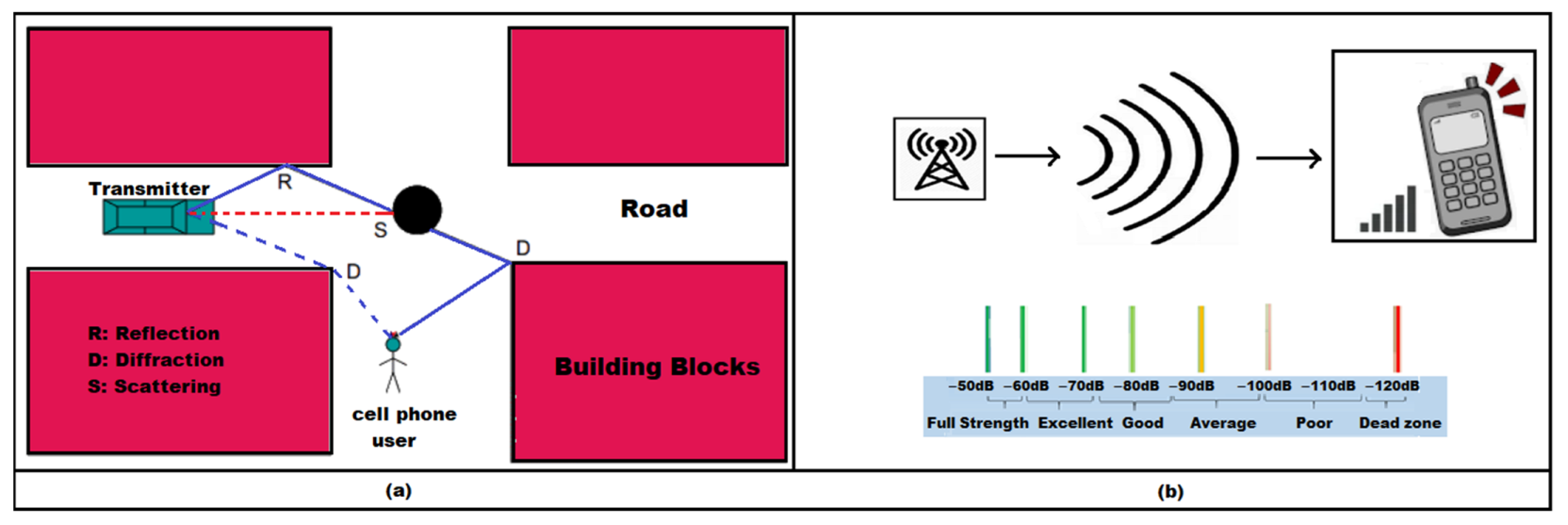
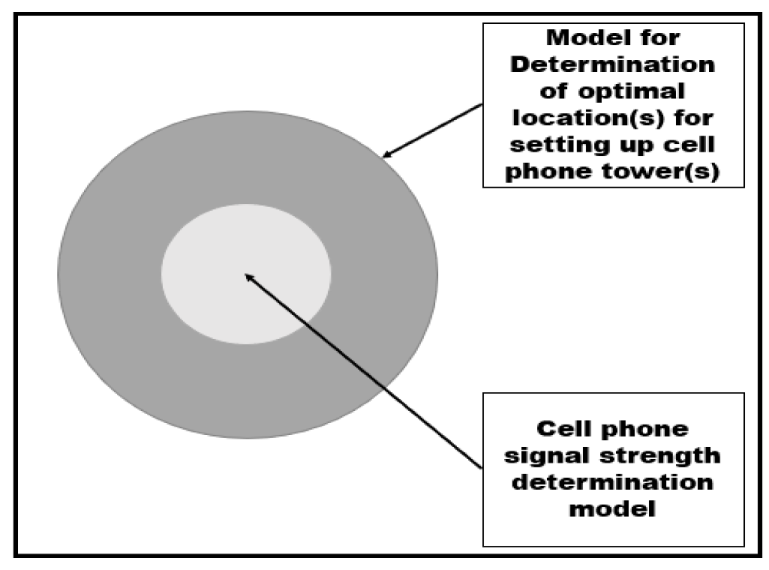

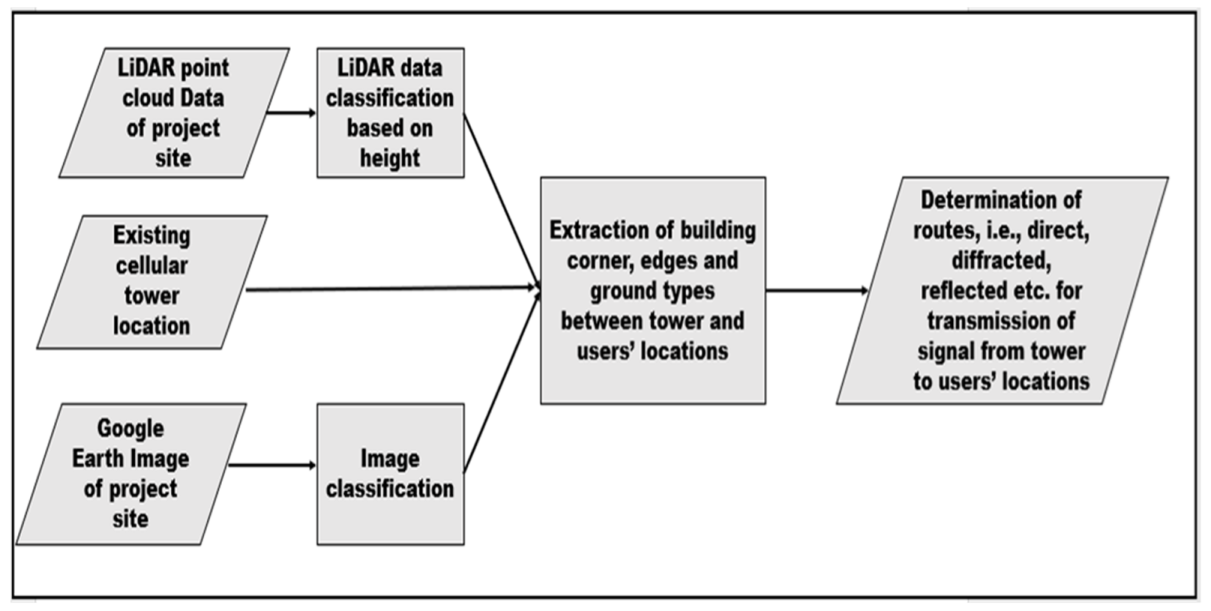
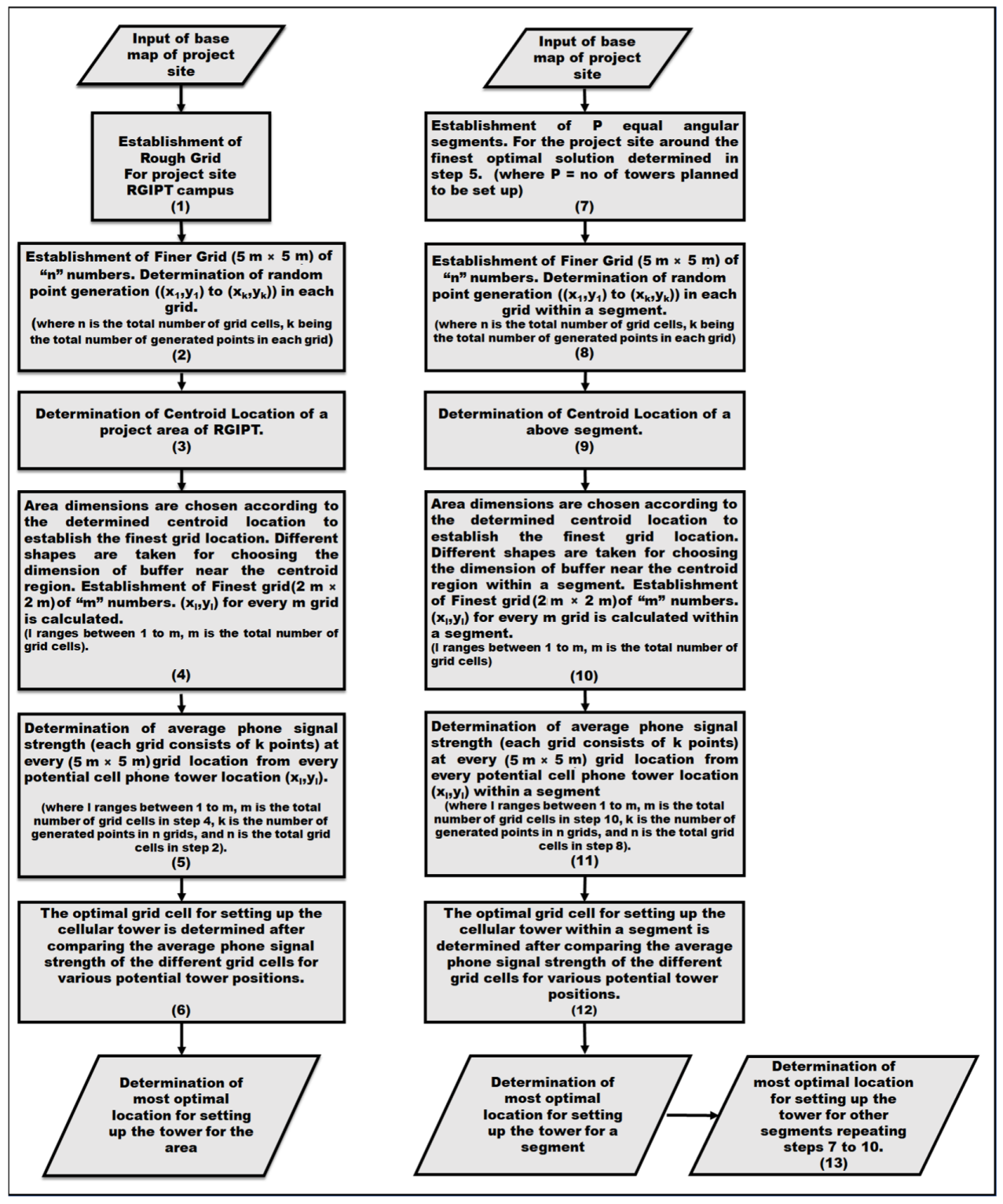
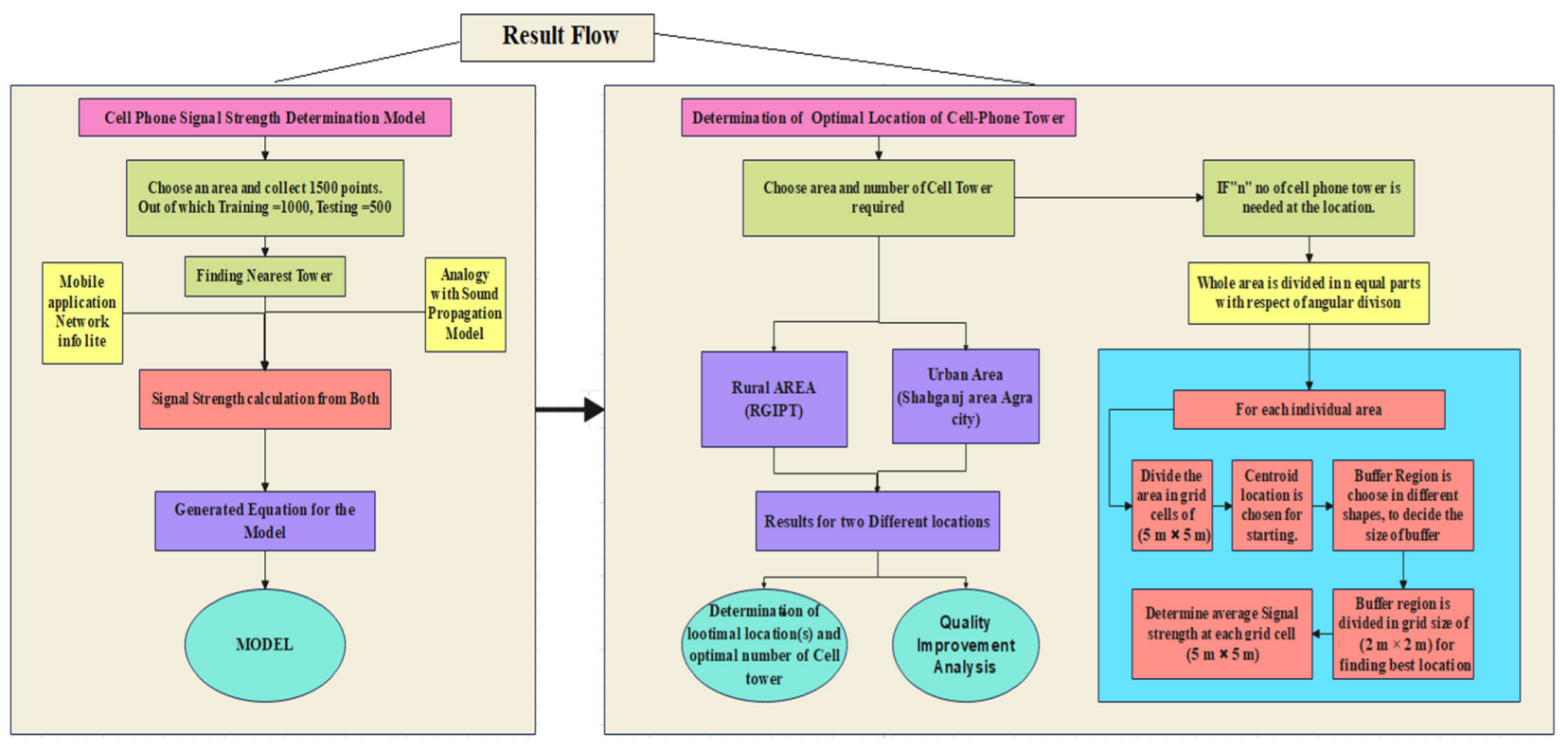
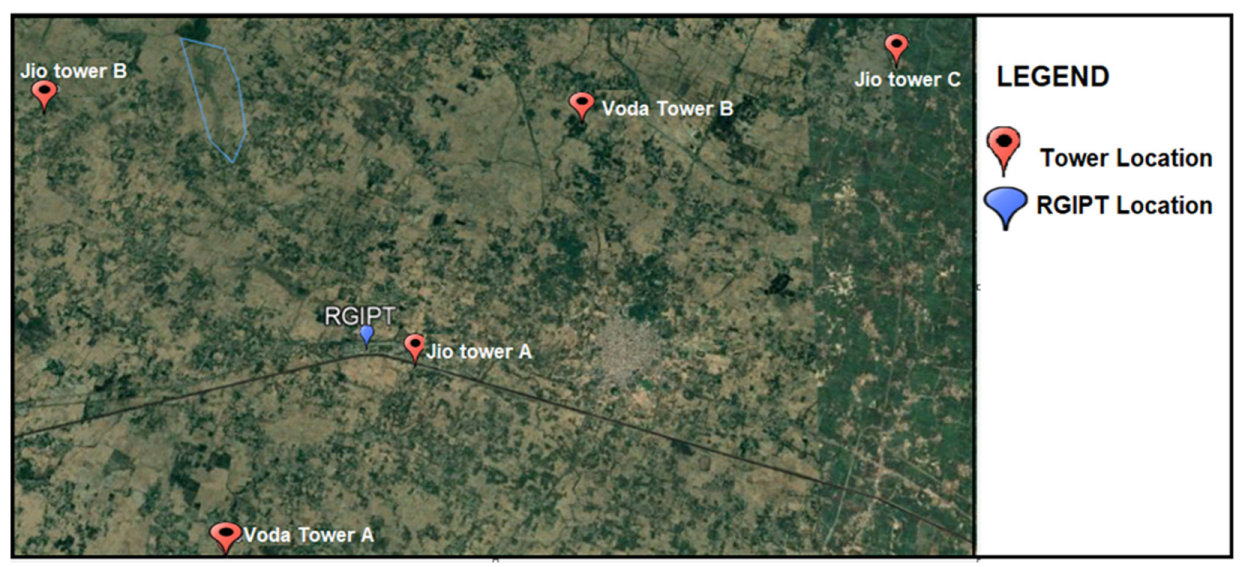

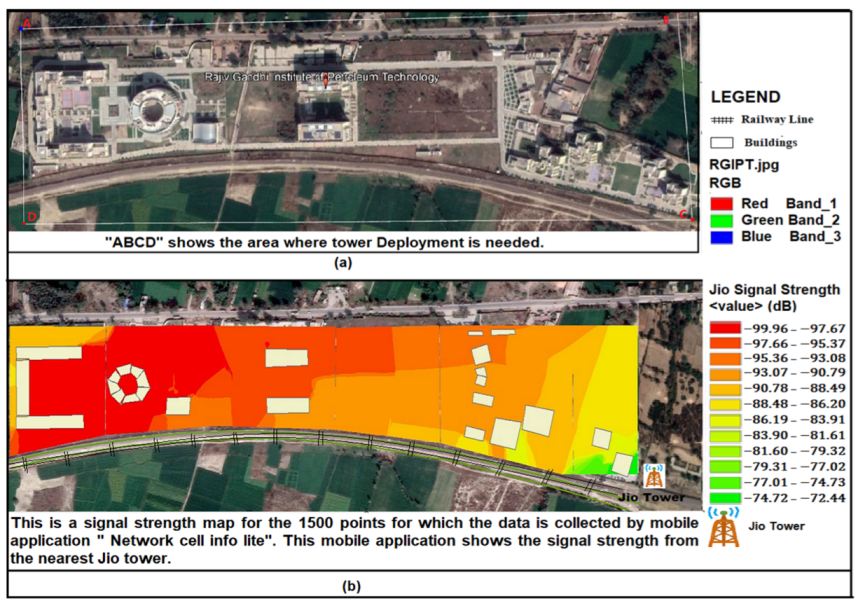
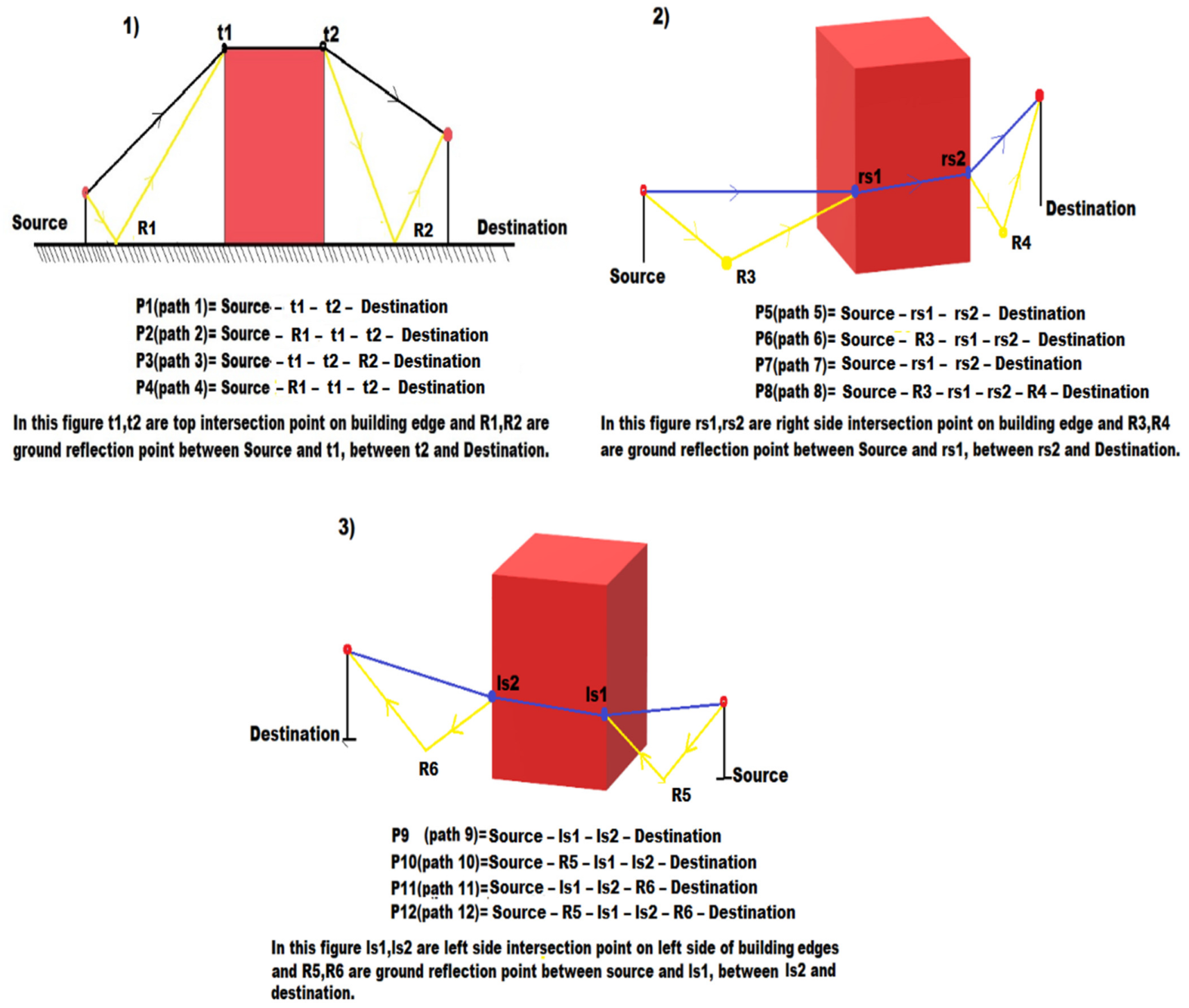

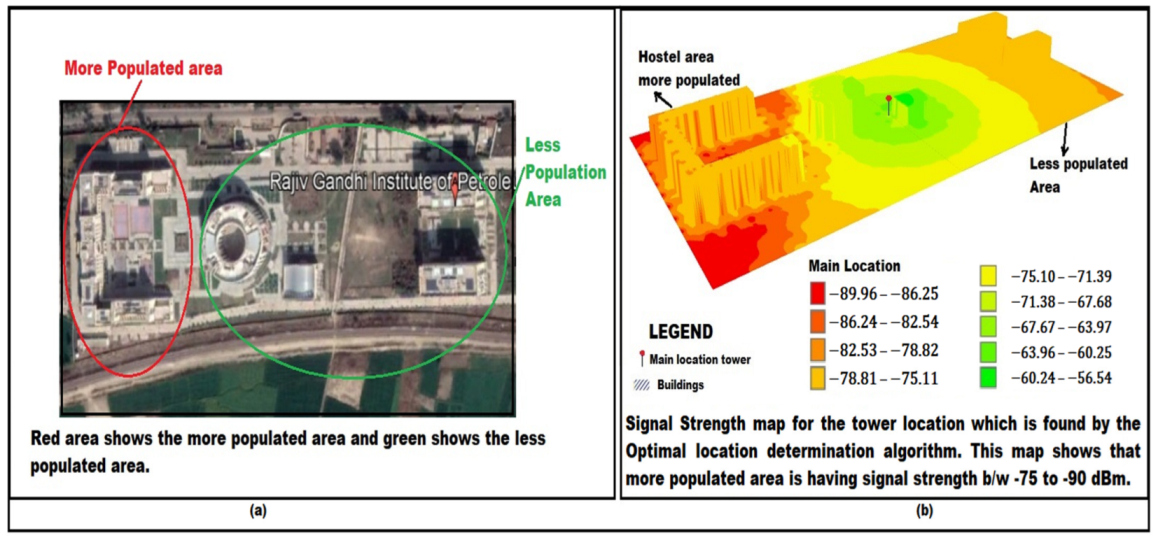
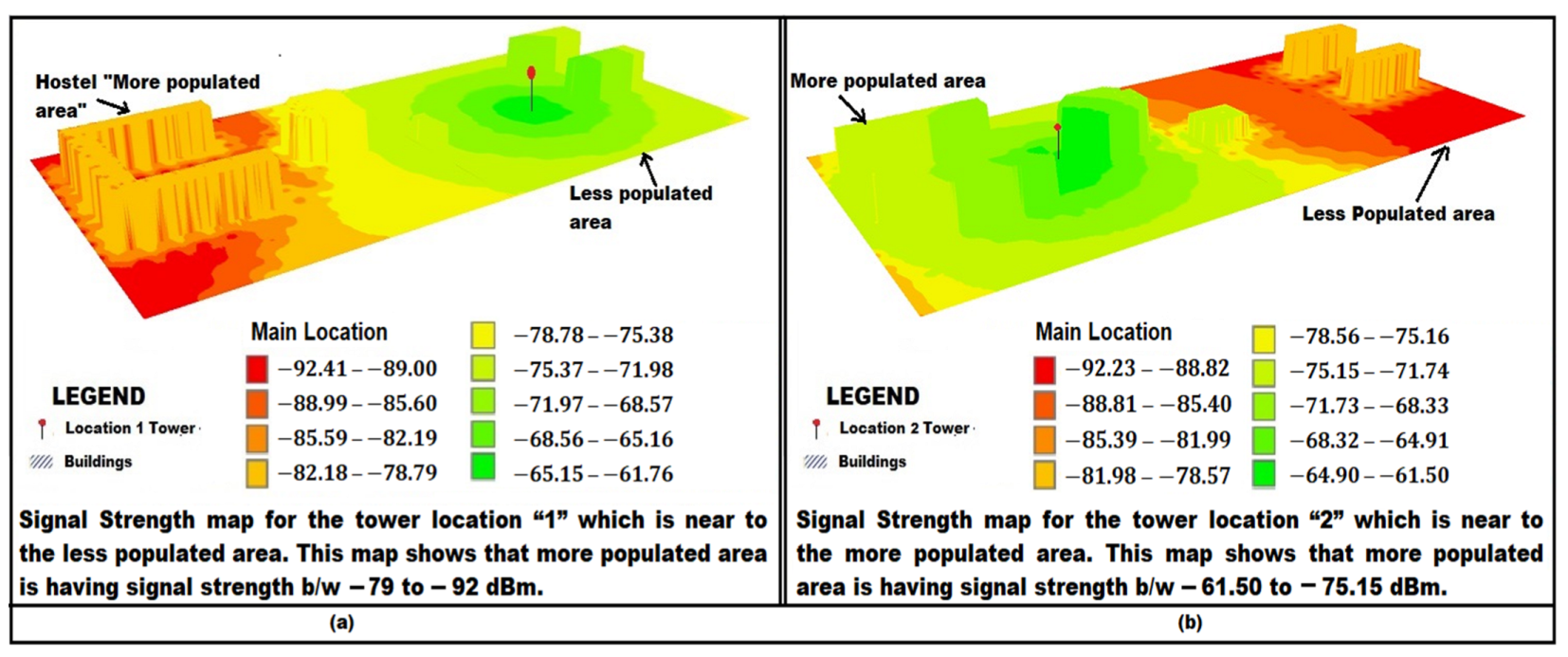
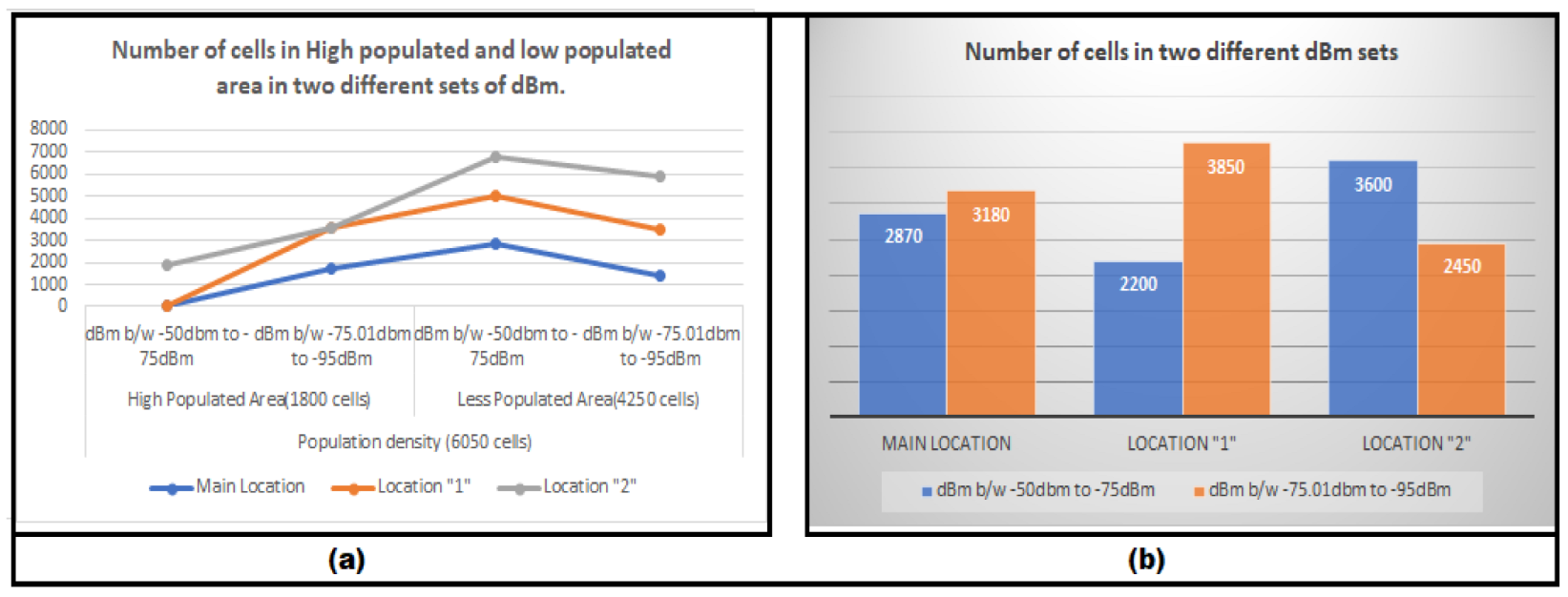
| Improvement in Signal Strength (RGIPT Small Area Total Cell 6050 Cells of (5 m × 5 m) Grid) | |
|---|---|
| % Population gets (range −50 to −75 dB m) | |
| Main Location | 47.43801653 |
| Location “1” (Tower towards lower population) | 36.36363636 |
| Location “2” (Tower towards higher population) | 59.50413223 |
Publisher’s Note: MDPI stays neutral with regard to jurisdictional claims in published maps and institutional affiliations. |
© 2022 by the authors. Licensee MDPI, Basel, Switzerland. This article is an open access article distributed under the terms and conditions of the Creative Commons Attribution (CC BY) license (https://creativecommons.org/licenses/by/4.0/).
Share and Cite
Bharadwaj, S.; Dubey, R.; Zafar, M.I.; Tiwary, S.K.; Faridi, R.A.; Biswas, S. A Novel Method to Determine the Optimal Location for a Cellular Tower by Using LiDAR Data. Appl. Syst. Innov. 2022, 5, 30. https://doi.org/10.3390/asi5020030
Bharadwaj S, Dubey R, Zafar MI, Tiwary SK, Faridi RA, Biswas S. A Novel Method to Determine the Optimal Location for a Cellular Tower by Using LiDAR Data. Applied System Innovation. 2022; 5(2):30. https://doi.org/10.3390/asi5020030
Chicago/Turabian StyleBharadwaj, Shruti, Rakesh Dubey, Md Iltaf Zafar, Saurabh Kr Tiwary, Rashid Aziz Faridi, and Susham Biswas. 2022. "A Novel Method to Determine the Optimal Location for a Cellular Tower by Using LiDAR Data" Applied System Innovation 5, no. 2: 30. https://doi.org/10.3390/asi5020030
APA StyleBharadwaj, S., Dubey, R., Zafar, M. I., Tiwary, S. K., Faridi, R. A., & Biswas, S. (2022). A Novel Method to Determine the Optimal Location for a Cellular Tower by Using LiDAR Data. Applied System Innovation, 5(2), 30. https://doi.org/10.3390/asi5020030






